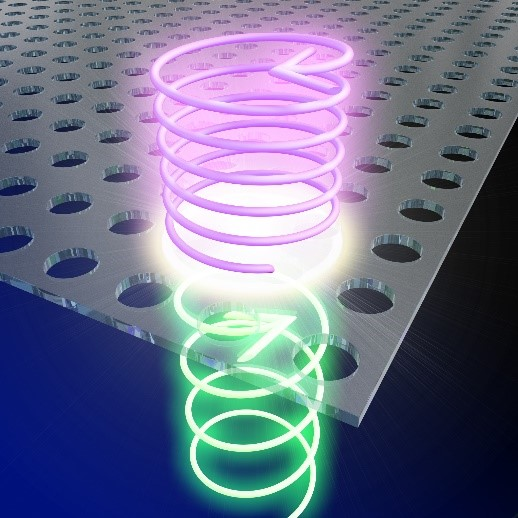Jul 23 2020
The technique of spectroscopy involves using light to analyze biological samples and physical objects. Information of different types can be derived using different types of light.
 Twisted light. Circularly polarized laser light goes through the PCN device and comes out the other side as VUV polarized in the opposite direction. Image Credit: © 2020 Konishi et al.
Twisted light. Circularly polarized laser light goes through the PCN device and comes out the other side as VUV polarized in the opposite direction. Image Credit: © 2020 Konishi et al.
Vacuum ultraviolet light is useful as it can help researchers in a wide range of research fields. However, it has been challenging and expensive to generate a light of this kind. Therefore, researchers developed a new device to efficiently produce this unique kind of light with the help of an ultrathin film that includes nanoscale perforations.
The wavelengths of light individuals view with their eyes comprise a mere fraction of the probable wavelengths of light that occur. It includes infrared light, which can be felt in the form of heat, or viewed by a snake, and has a longer wavelength compared to visible light.
Ultraviolet (UV) light lies at the opposite end of the spectrum and can be used to produce vitamin D in human skin. It can be viewed by bees. These and other types of light find several applications in science.
Vacuum ultraviolet light (VUV), which is a subset of wavelengths within the UV range, is named so as they can pass through a vacuum although they are easily absorbed by air. Certain VUV wavelengths in the region of around 120-200 nm are specifically useful to researchers, particularly medical researchers, as they can be employed for physical and chemical analyses of various materials and even biological samples.
But light exhibits more features than just its wavelength. To make VUV highly useful, it must polarized or twisted to circular polarization. Current techniques to produce VUV—for example, the use of laser-driven plasmas and particle accelerators—pose several disadvantages, such as complexity, cost, and scale.
Moreover, these can generate only untwisted linear polarized VUV. A simple technique to produce circularly polarized VUV would be very helpful, if available. Assistant Professor Kuniaki Konishi from the Institute for Photon Science and Technology at the University of Tokyo and his colleagues could just have found the solution.
We have created a simple device to convert circularly polarized visible laser light into circularly polarized VUV, twisted in the opposite direction. Our photonic crystal dielectric nanomembrane (PCN) consists of a sheet made from an aluminum oxide-based crystal (γ-Al2O3) only 48 nm thick. It sits atop a 525 micrometer-thick sheet of silicon which has 190 nm-wide holes cut into it 600 nm apart.
Kuniaki Konishi, Institute for Photon Science and Technology, University of Tokyo
The PCN membrane resembles a flat featureless surface to human eyes. However, the perforation pattern is visible when viewed under a powerful microscope. It somewhat resembles the holes in a showerhead that increase the water pressure to make jets.
When pulses of circularly polarized blue laser light with a wavelength of 470 nm shine down these channels in the silicon, the PCN acts on these pulses and twists them in the opposing direction. It also shrinks their wavelengths to 157 nm which is well within the range of VUV that is so useful in spectroscopy.
Kuniaki Konishi, Institute for Photon Science and Technology, University of Tokyo
Researchers can use short pulses of circularly polarized VUV to observe short-lived or fast physical phenomena at the submicrometer scale, which are otherwise impossible to observe. These phenomena include the behaviors of biomolecules or electrons.
Therefore, this new technique to produce VUV could prove helpful to researchers in the fields of molecular chemistry, medicine, solid-state physics, and life sciences.
A similar technique that was demonstrated earlier generated very less useful longer wavelengths by using a metal-based film, which is prone to quick degradation upon exposure to laser light. In comparison, PCN is much more durable.
I am pleased that through our study of PCN, we found a new and useful application for circularly polarized light conversion, generating VUV with the intensity required to make it ideal for spectroscopy.
Kuniaki Konishi, Institute for Photon Science and Technology, University of Tokyo
“And it was surprising that the PCN membrane could survive the repeated bombardment of laser light, unlike previous metal-based devices. This makes it suitable for lab use where it may be used extensively over long periods. We did this for basic science and I hope to see many kinds of researchers make good use of our work,” added Konishi.
Journal Reference:
Konishi, K., et al. (2020) Circularly polarized vacuum ultraviolet coherent light generation using a square lattice photonic crystal nanomembrane. Optica. doi.org/10.1364/OPTICA.393816.